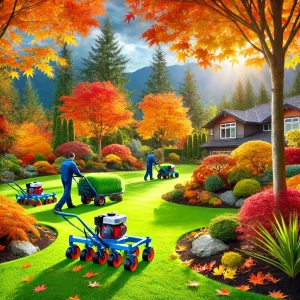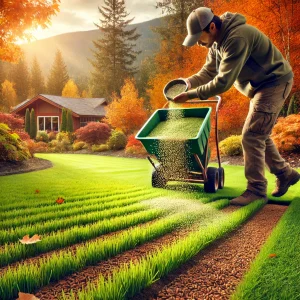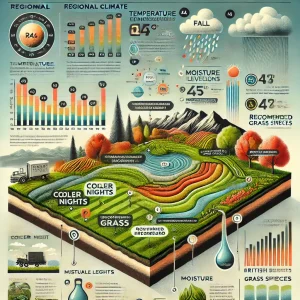As the leaves start to turn and temperatures cool, fall becomes a critical time for commercial landscapes in British Columbia. This season offers an ideal window for lawn care that prepares the ground for winter and ensures lush growth come spring. The TurfMutt Foundation emphasizes the importance of fall lawn care, focusing on practices like aeration, overseeding, and fertilizing, which are vital for maintaining healthy turf in commercial spaces. Let’s explore how these techniques can transform your landscape and offer immediate and long-term benefits for your business.

Why Fall Matters for Commercial Lawn Care
In British Columbia’s temperate climate, fall presents the perfect opportunity to address the health of your lawn. Cooler temperatures and increased rainfall create optimal soil rejuvenation and plant growth conditions. Preparing your commercial landscape during this season sets the foundation for winter and ensures your lawn will thrive with minimal effort once spring arrives.
For businesses, a well-maintained landscape is more than just aesthetic—it’s a statement of professionalism. Taking proactive steps during the fall season can lead to cost savings, reduced maintenance needs, and enhanced curb appeal in the long run.

Aeration: Enhancing Soil Health
Aeration is the process of perforating the soil to allow air, water, and nutrients to penetrate the grass roots. Over time, commercial lawns experience compaction due to heavy foot traffic, making it difficult for the grass to absorb the nutrients it needs. By aerating in the fall, you create the perfect environment for more vigorous, healthier turf.
IslandEarth Landscape, a leading commercial landscaping company in British Columbia, incorporates fall aeration as a cornerstone of its lawn care services. Their team explains that loosening compacted soil before winter ensures that water and nutrients reach the roots, which helps with rapid growth once spring returns. Aeration prevents waterlogging by improving drainage in regions like Vancouver Island, where heavy rains are expected.

Overseeding: Filling in the Gaps
After aeration, overseeding is a highly effective way to rejuvenate tired lawns and fill in bare spots. The TurfMutt Foundation recommends overseeding in the fall because the cooler temperatures and frequent rainfall create ideal conditions for seed germination. In British Columbia, where commercial lawns endure high usage, overseeding in the fall helps maintain dense, vibrant grass without starting from scratch in the spring.
IslandEarth Landscape often uses drought-tolerant fescue and perennial ryegrass for their overseeding projects. These grass species are well-suited to the region’s fall climate and help conserve water, a crucial consideration for eco-conscious businesses. By choosing the right grass varieties, businesses can reduce water consumption and lower maintenance costs.

Fertilizing: Feeding for the Future
Fall fertilization gives your lawn the nutrients it needs to survive the winter and bounce back in spring. The TurfMutt Foundation advises applying a slow-release fertilizer rich in potassium, which strengthens roots and enhances their ability to resist disease and harsh winter conditions.
In British Columbia’s climate, fertilizing in the fall is particularly important because it promotes root growth when the grass blades grow more slowly. IslandEarth Landscape applies organic, nutrient-rich fertilizers to its commercial properties, ensuring that the soil remains healthy and supports lush growth year-round. This approach helps businesses reduce their environmental impact and cuts down on the need for chemical treatments later on.

Regional Climate Considerations
British Columbia’s mild fall temperatures and increased rainfall make it an ideal time for lawn care, but it’s important to tailor your strategy to the region’s unique conditions. Cooler nights and shorter days slow grass growth, so focusing on root health and soil conditioning during this period is essential. Coastal regions, such as Victoria and Vancouver Island, experience more moisture, leading to over-saturation if proper drainage is needed. Aeration and choosing the right grass species, like those mentioned above, can help mitigate these challenges.

Cost Savings and Long-Term Benefits
Businesses can save significantly on future maintenance costs by investing in fall lawn care. Healthier lawns require less water, fewer chemical treatments, and reduced mowing, all of which contribute to long-term savings. Fall is also a prime time to address any existing issues, such as bare patches or compacted soil before they become bigger problems in the spring.
Furthermore, well-maintained commercial landscapes enhance property value and curb appeal, leaving a lasting impression on clients and visitors. The upfront investment in fall lawn care pays off in reduced upkeep and a more visually appealing space throughout the year.

Maximizing your commercial landscape’s potential during the fall season is essential for ensuring lush, healthy growth come spring. By following the tips recommended by the TurfMutt Foundation—such as aeration, overseeding, and fertilizing—you can enhance soil health, promote root growth, and create a more resilient landscape. With examples from IslandEarth Landscape in British Columbia, it’s clear that businesses can reap both immediate and long-term benefits from investing in fall lawn care. In a region where environmental consciousness and professional image go hand in hand, fall landscaping is the key to staying ahead.
Start preparing your commercial lawn now; your landscape will thank you in the spring!